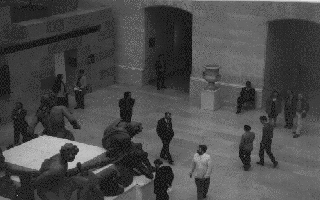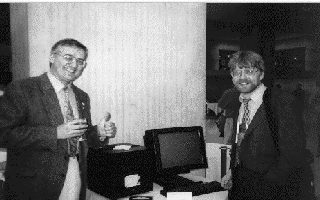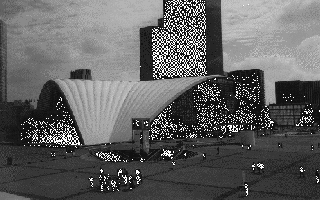Netskills Corner: Fifth WWW Conference, Paris
About the Conference
The fifth World Wide Web conference was held at CNIT, La Défense in Paris from 6-10th May 1996. The conference began with a day of tutorials and workshops and concluded with a developer’s day. The technical programme took place on the 7-9th May. In addition a Small to Medium Enterprises (SME) Forum was held on 9-10th May.
Impressions
The WWW conference has certainly changed since the first conference was held at CERN in May 1994. It is difficult to believe that only two years have passed since that date. The conference has grown in size from 380 participants at the first conference, to over 2,000 in Paris.

Lots of men in suits were present at the conference
I did not think there were any earth-shattering papers or announcements at the conference. However there were announcements in a number of areas of interest to me:
- HTML 3.2 announced
HTML 3.2 is W3C’s new specification for HTML. The new specification has been agreed by the major vendors including Microsoft, Sun, Netscape and IBM. For further information see the URL http://www.w3.org/pub/WWW/MarkUp/Wilbur/ - Style Sheets
The style sheet proposal appears to be mature and has been implemented in Microsoft’s Internet Explorer (version 3, beta). The Amaya browser / editing tool, which will be freely available shortly, will enable style sheets to be edited. For further information on style sheets see the URL http://www.w3.org/pub/WWW/Style/ - HTTP/1.1
A number of changes have been made to the HTTP/1.1 draft specification, including changes to content negotiation (mechanisms for dialogue between clients and servers regarding document formats). For further information see the URL http://www.w3.org/pub/WWW/Protocols/
The conference consisted of paper sessions, panel sessions, invited presentations and W3C sessions. A summary of the sessions I attended follows.
Paper Sessions
The first paper session I attended was on Web Characteristics. The papers were:
- An Investigation of Documents From the WWW
- Allison Woodruff, Paul Aoki, Eric Brewer, Paul Gauthier and Lawrence Rowe
- From User Access Patterns to Dynamic Hypertext Linking
- Tak Woon Yan, Mathew Jacobsen, Hector Garcia-Molina and Umeshwar Dayal
- Measuring the Web
- Tim Bray
Allison Woodruff et al’s paper provided a useful summary on the usage of HTML tags in a large number of documents.
I was impressed by Tim Bray’s paper on measuring the Web. This analysis covered connections to and from HTML documents. A VRML display of the Web was provided, which provided a graphical illustration of a number of features, including the size of a site, and the numbers of pointers from the site and the numbers of pointers to the site.
Tak Woon Yan et als paper provided an analysis of usage for an individual browsing a Web site, and used clustering techniques to suggest related pages which other users have accessed. This is likely to be a feature of commercial sites, such as virtual shopping malls (“We noticed you’ve access the tennis pages and the pages on holidays in the Bahamas. You might also be interested in our pages on camera equipment”).
The next paper session I attended was on Document Structures in which the following papers were presented:
- Interactively Restructuring HTML Documents
- Stéphane Bonhomme, Cécile Roisin
- HTML Generation and Semantic Markup For Telepathology
- Vicenzo Della Mea, Vito Roberto, Davide Brunato and Carlo Alberto Beltrami
- Extending the Web’s Tag Set Using SGML: The Grif Symposia Authoring Tool
- Jean Paoli
Stéphane Bonhomme and Cécile Roisin’s paper described techniques for restructuring HTML documents (e.g. automatically converting a bulleted list to a table). The importance of having correctly structured documents was made very clear in this talk.
Vicenzo Della Mea et al’s paper illustrated how they had added HTML tags to define a structure to a database application they had developed. This work was similar to Simon Dobson and Victoria Marshall’s paper on Light-Weight Databases which was presented at a previous WWW conference.
Jan Paoli’s paper described a technique for extending HTML based on extensions to the HTML DTD.
I then chaired a session on Browsing Aids:
- Automatically Organising Bookmarks per Contents
- Yoelle Maarek and Israel Ben Shaul
- WebGUIDE: Querying and Navigating Changes in Web Repositories
- Fred Douglis, Thomas Ball, Yih-Farn Chen and Eleftherios Koutsofios
- Nif-t-nav: A Hierarchical Navigator for WWW Pages
- Kirsten Jones
Yoelle Maarek and Israel Ben Shaul described an interesting technique for automating management of bookmark files based on clustering techniques.
Fred Douglis et al described software for visualising changes to different generations of HTML documents.
Kirsten Jones’ paper described a technique for providing state when navigating Web directory structures.
Keynote Sessions
Stuart Weibel, Online Computer Library Center (OCLC), gave a presentation on Mending Our Net: Gathering, Describing, and Preserving Information in a Digital World. It was interesting to hear Stuart’s introduction to the subject of meta-data: he described how IETF working group meeting resembled the film Groundhog Day, with every meeting seeming to repeat the discussion topics aired at previous meetings. In light of the difficultituies of advancing URN (Uniform Resource Names) Stuart suggested that PURLS (Persistent URLs) could have a role to play.
Bob Scheifler, X Consortium, then gave a talk on Broadway: Universal Access to Interactive Applications Over The Web. The goal of Broadway is to “provide universal access to interactive applications on the Web - the ability to locate and invoke remote applications via the Web and have their displays, including both graphics and audio, appear wherever you are, either as new top-level windows or embedded within a Web browser”. For further information see the URL http://www.x.org/consortium/broadway.html
Developer’s Sessions
At the Developer’s Day, Dave Raggett and Håkon Lie gave a summary of developments to HTML and Style Sheets. HTML 3.2 was announced, which should bring to an end the HTML extensions wars which were threatening to pull apart the Web community.
HTML 3.2 will include a number of widely deployed features, including:
- tables
- applets
- text flow around images
- superscripts and subscripts
In addition it will include a number of widely-adopted HTML extensions (such as <BODY BACKGROUND>, <BIG> and <SMALL>).
Following these two presentations, a speaker from Netscape was introduced, and then Chris Wilson (Microsoft) gave a talk on the issues associated with writing software to support style sheets. Chris described the importance of document structure and tag containers. He described the difficulties of implementing support for document containing invalid HTML constructs For example:
<B>Bold text<I>Bold Italic text</B> what’s this</I>what’s this?
can be interpreted in a number of ways. When attempting to analyse such invalid HTML constructs, errors could be introduced (e.g. using tools to create style sheets). For example, the example shown above could be interpreted as:
- <B>Bold text<I>Bold Italic text</I> </B>what’s this</I>what’s this?
- An implied </I>
- <B>Bold text<I>Bold Italic text what’s this</I>what’s this?
- Ignore the </B> tag
However, automatically generating HTML tags can cause problems, if, for example, <FRAME> or <FORM> tags had to be generated. (Note the high proportion of document containing errors given in the URL http://www.cs.berkeley.edu/~woodruff/inktomi/results_syntax.html).
Chris made the following recommendations:
- Validate your documents
- Understand HTML containers and use them properly
- Don’t use clever tricks to obtain a visual effect
Following the presentations there was a panel session. The following questions were asked:
- Are the HTML wars over? Will be see the end of vendor-specific HTML extensions?
- Although HTML 3.2 has been agreed, inevitably new features will be introduced, and this is needed to prevent the Web from stagnating.
- Will there be support for folded lists (e.g. outline views of documents)?
- This can be implemented in a number of ways (e.g. using Javascript, and perhaps using style sheets)
- What has happened to maths?
- A small W3C working group has been set up. Prototypes should be available by the end of the year.
- Why are the <OBJECT> and <APPLET> tags both provided?
- To continue to provide support for the widely deployed <APPLET> tag
- Will the <LI> tag support coloured bullets?
- Yes
- When will HTML provide support for international character sets?
- HTML can use Unicode, but font support is needed (this is coming)
Other Comments
Although 58 papers were selected for presentation in the parallel sessions at the Conference, it was disappointing that only three (Neil Smith’s paper on The UK National Web Cache - The State of the Art, Dave Ingham et al’s paper on Fixing The “Broken Link” Problem: The W3Objects Approach and Leslie Carr et al’s paper on Open Information Systems) were from the UK HE community.
At the first WWW conference many of the speakers gave their presentations using OHP foils. At that conference only one speaker (Dave Raggett) gave his presentation using the Web. This time, in comparison, all speakers were requested to make their slides available in HTML format. The files were then displayed using a Web browser (Netscape). Although this did not provide the layout control available using desktop presentation packages such as PowerPoint, it was good to see the Web being used in this way. Indeed two speakers (Chris Lilley and Håkon Lie) used the Arena browser with style sheets to provide a high degree of control over the screen display.
Social Programme
The higlight of the social programme was the conference buffet, held in Le Louvre. A modern exhibit was on display at the museum. Robert Cailliau brought along Tim Berners-Lee’s original NeXT computer, which was used to produce the initial WWW browser and server.

Robert Cailliau, Brian Kelly and Tim Berners-Lee’s NeXT computer
The low point of the conference occured on the Sunday. After registering I managed to find a computer and accessed the Carling football pages, only to discover that Manchester United were winning, and Newcastle were drawing :-(
Further Information
Details of the conference are available at the URL http://www.w3.org/pub/Conferences/WWW5/Welcome.html
Conference papers are available at the URL http://www.w3.org/pub/Conferences/WWW5/fich_html/paper-sessions.html
Details on next year’s WWW Conference are available at the URL http://www6conf.slac.stanford.edu/

